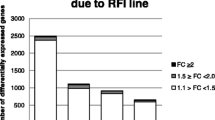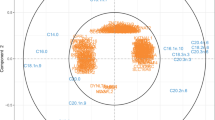Abstract
The competitive equilibrium of fatty acid biosynthesis and oxidation in vivo determines porcine subcutaneous fat thickness (SFT) and intramuscular fat (IMF) content. Obese and lean-type pig breeds show obvious differences in adipose deposition; however, the molecular mechanism underlying this phenotypic variation remains unclear. We used pathway-focused oligo microarray studies to examine the expression changes of 140 genes associated with meat quality and carcass traits in backfat at five growth stages (1–5 months) of Landrace (a leaner, Western breed) and Taihu pigs (a fatty, indigenous, Chinese breed). Variance analysis (ANOVA) revealed that differences in the expression of 25 genes in Landrace pigs were significant (FDR adjusted permutation, P<0.05) among 5 growth stages. Gene class test (GCT) indicated that a gene-group was very significant between 2 pig breeds across 5 growth stages (PErmineJ<0.01), which consisted of 23 genes encoding enzymes and regulatory proteins associated with lipid and steroid metabolism. These findings suggest that the distinct differences in fat deposition ability between Landrace and Taihu pigs may closely correlate with the expression changes of these genes. Clustering analysis revealed a very high level of significance (FDR adjusted, P<0.01) for 2 gene expression patterns in Landrace pigs and a high level of significance (FDR adjusted, P<0.05) for 2 gene expression patterns in Taihu pigs. Also, expression patterns of genes were more diversified in Taihu pigs than those in Landrace pigs, which suggests that the regulatory mechanism of micro-effect polygenes in adipocytes may be more complex in Taihu pigs than in Landrace pigs. Based on a dynamic Bayesian network (DBN) model, gene regulatory networks (GRNs) were reconstructed from time-series data for each pig breed. These two GRNs initially revealed the distinct differences in physiological and biochemical aspects of adipose metabolism between the two pig breeds; from these results, some potential key genes could be identified. Quantitative, real-time RT-PCR (QRT-PCR) was used to verify the microarray data for five modulated genes, and a good correlation between the two measures of expression was observed for both 2 pig breeds at different growth stages (R=0.874±0.071). These results highlight some possible candidate genes for porcine fat characteristics and provide some data on which to base further study of the molecular basis of adipose metabolism.
Similar content being viewed by others
References
Fiedler I, Nürnberg K, Hardge T, et al. Phenotypic variations of muscle fibre and intramuscular fat traits in longissimus muscle of F2 population Duroc×Berlin Miniature Pig and relationships to meat quality. Meat Sci, 2003, 63: 131–139, 10.1016/S0309-1740(02)00075-X, 10.1016/S0309-1740(02)00075-X
Plastow G S, Carrión D, Gil M, et al. Quality pork genes and meat production. Meat Sci, 2005, 70: 409–421, 10.1016/j.meatsci.2004.06.025, 1:CAS:528:DC%2BD2MXktVKgtrc%3D, 10.1016/j.meatsci.2004.06.025, 1:CAS:528:DC%2BD2MXktVKgtrc%3D
Suzuki K, Irie M, Kadowaki H, et al. Genetic parameter estimates of meat quality traits in Duroc pigs selected for average daily gain, longissimus muscle area, backfat thickness, and intramuscular fat content. J Anim Sci, 2005, 83: 2058–2065, 16100060, 1:CAS:528:DC%2BD2MXpsFGit78%3D, 16100060, 1:CAS:528:DC%2BD2MXpsFGit78%3D
Ailhaud G. Adipose tissue as a secretory organ: From adipogenesis to the metabolic syndrome. C R Biol, 2006, 329: 570–577, 16860275, 10.1016/j.crvi.2005.12.012, 1:CAS:528:DC%2BD28XntVSqu7s%3D, 16860275, 10.1016/j.crvi.2005.12.012, 1:CAS:528:DC%2BD28XntVSqu7s%3D
Editorial Committee of “Pig Breeds in China”. Pig Breeds in China (in Chinese). Shanghai: Scientific & Technical Publishing House, 1986. 155–160
Khatri P, Bhavsar P, Bawa G, et al. Onto-Tools: An ensemble of web-accessible, ontology-based tools for the functional design and interpretation of high-throughput gene expression experiments. Nucleic Acids Res, 2004, 32(Web Server issue): W449–W456, 15215428, 10.1093/nar/gkh409, 1:CAS:528:DC%2BD2cXlvFKnu7o%3D, 15215428, 10.1093/nar/gkh409, 1:CAS:528:DC%2BD2cXlvFKnu7o%3D
Doms A, Schroeder M. GoPubMed: Exploring PubMed with the Gene Ontology. Nucleic Acids Res, 2005, 33(Web Server issue): W783–W786, 15980585, 10.1093/nar/gki470, 1:CAS:528:DC%2BD2MXlslyqtL0%3D, 15980585, 10.1093/nar/gki470, 1:CAS:528:DC%2BD2MXlslyqtL0%3D
Yang Y H, Speed T. Design issues for cDNA microarray experiments. Nat Rev Genet, 2002, 3: 579–588, 12154381, 1:CAS:528:DC%2BD38XlslamsLs%3D, 12154381, 1:CAS:528:DC%2BD38XlslamsLs%3D
Yang Y H, Dudoit S, Luu P, et al. Normalization for cDNA microarray data: A robust composite method addressing single and multiple slide systematic variation. Nucleic Acids Res, 2002, 30(4): e15–e24, 11842121, 10.1093/nar/30.4.e15, 11842121, 10.1093/nar/30.4.e15
Xia X, McClelland M, Wang Y. WebArray: An online platform for microarray data analysis. BMC Bioinformatics, 2005, 6: 306–311, 16371165, 10.1186/1471-2105-6-306, 16371165, 10.1186/1471-2105-6-306
Smyth G K, Michaud J, Scott H S. Use of within-array replicate spots for assessing differential expression in microarray experiments. Bioinformatics, 2005, 21: 2067–2075, 15657102, 10.1093/bioinformatics/bti270, 1:CAS:528:DC%2BD2MXjsl2nsLo%3D, 15657102, 10.1093/bioinformatics/bti270, 1:CAS:528:DC%2BD2MXjsl2nsLo%3D
Troyanskaya O, Cantor M, Sherlock G, et al. Missing value estimation methods for DNA microarrays. Bioinformatics, 2001, 17: 520–525, 11395428, 10.1093/bioinformatics/17.6.520, 1:CAS:528:DC%2BD3MXltFOgsLY%3D, 11395428, 10.1093/bioinformatics/17.6.520, 1:CAS:528:DC%2BD3MXltFOgsLY%3D
Kerr M K, Martin M, Churchill G A. Analysis of variance for gene expression microarray data. J Comput Biol, 2000, 7: 819–837, 11382364, 10.1089/10665270050514954, 1:CAS:528:DC%2BD3MXis1Kktrc%3D, 11382364, 10.1089/10665270050514954, 1:CAS:528:DC%2BD3MXis1Kktrc%3D
Cui X, Hwang J T, Qiu J, et al. Improved statistical tests for differential gene expression by shrinking variance components estimates. Biostatistics, 2005, 6: 59–75, 15618528, 10.1093/biostatistics/kxh018, 15618528, 10.1093/biostatistics/kxh018
Lee H K, Braynen W, Keshav K, et al. ErmineJ: Tool for functional analysis of gene expression data sets. BMC Bioinformatics, 2005, 6: 269–276, 16280084, 10.1186/1471-2105-6-269, 16280084, 10.1186/1471-2105-6-269
Ernst J, Bar-Joseph Z. STEM: A tool for the analysis of short time series gene expression data. BMC Bioinformatics, 2006, 7: 191–121, 16597342, 10.1186/1471-2105-7-191, 16597342, 10.1186/1471-2105-7-191
Wu C C, Huang H C, Juan H F, et al. GeneNetwork: An interactive tool for reconstruction of genetic networks using microarray data. Bioinformatics, 2004, 20: 3691–3693, 15271782, 10.1093/bioinformatics/bth428, 1:CAS:528:DC%2BD2cXhtVOjsr%2FL, 15271782, 10.1093/bioinformatics/bth428, 1:CAS:528:DC%2BD2cXhtVOjsr%2FL
Dojer N, Gambin A, Mizera A, et al. Applying dynamic Bayesian networks to perturbed gene expression data. BMC Bioinformatics, 2006, 7: 249–259, 16681847, 10.1186/1471-2105-7-249, 16681847, 10.1186/1471-2105-7-249
Erkens T, Van Poucke M, Vandesompele J, et al. Development of a new set of reference genes for normalization of real-time RT-PCR data of porcine backfat and longissimus dorsi muscle, and evaluation with PPARGC1A. BMC Biotechnol, 2006, 6: 41–48, 17026777, 10.1186/1472-6750-6-41, 17026777, 10.1186/1472-6750-6-41
Vandesompele J, De Preter K, Pattyn F, et al. Accurate normalization of real-time quantitative RT-PCR data by geometric averaging of multiple internal control genes. Genome Biol, 2002, 3: 34–45, 10.1186/gb-2002-3-7-research0034, 10.1186/gb-2002-3-7-research0034
Anderson D B, Kauffman R G. Celluar and enzymatic changes in porcine adipose tissue during growth. J Lipid Res, 1973, 14: 160–168, 4698264, 1:CAS:528:DyaE3sXht1Wquro%3D, 4698264, 1:CAS:528:DyaE3sXht1Wquro%3D
Kolstad K. Fat deposition and distribution measured by computer tomography in three genetic groups of pigs. Livest Prod Sci, 2001, 67: 281–292, 10.1016/S0301-6226(00)00195-0, 10.1016/S0301-6226(00)00195-0
Datta S, Datta S. Empirical Bayes screening of many P values with applications to microarray studies. Bioinformatics, 2005, 21: 1987–1994, 15691856, 10.1093/bioinformatics/bti301, 1:CAS:528:DC%2BD2MXjsl2nt7o%3D, 15691856, 10.1093/bioinformatics/bti301, 1:CAS:528:DC%2BD2MXjsl2nt7o%3D
Allison D B, Cui X, Page G P, et al. Microarray data analysis: From disarray to consolidation and consensus. Nat Rev Genet, 2006, 7: 55–65, 16369572, 10.1038/nrg1749, 1:CAS:528:DC%2BD2MXhtlanu73F, 16369572, 10.1038/nrg1749, 1:CAS:528:DC%2BD2MXhtlanu73F
Yang H, Churchill G. Estimating P values in small microarray experiments. Bioinformatics, 2007, 23: 38–43, 17077100, 10.1093/bioinformatics/btl548, 1:CAS:528:DC%2BD28XhtlGktL3M, 17077100, 10.1093/bioinformatics/btl548, 1:CAS:528:DC%2BD28XhtlGktL3M
Chmurzyńska A. The multigene family of fatty acid-binding proteins (FABPs): Function, structure and polymorphism. J Appl Genet, 2006, 47: 39–48, 16424607, 16424607
Arnyasi M, Grindflek E, Jávor A, et al. Investigation of two candidate genes for meat quality traits in a quantitative trait locus region on SSC6: The porcine short heterodimer partner and heart fatty acid binding protein genes. J Anim Breed Genet, 2006, 123: 198–203, 16706925, 10.1111/j.1439-0388.2006.00588.x, 1:CAS:528:DC%2BD28XmsVGmtbc%3D, 16706925, 10.1111/j.1439-0388.2006.00588.x, 1:CAS:528:DC%2BD28XmsVGmtbc%3D
Li B, Zerby H N, Lee K. Heart fatty acid binding protein is up-regulated during porcine adipocyte development. J Anim Sci, 2007, 85: 1651–1659, 17431053, 10.2527/jas.2006-755, 1:CAS:528:DC%2BD2sXntV2ms7c%3D, 17431053, 10.2527/jas.2006-755, 1:CAS:528:DC%2BD2sXntV2ms7c%3D
Du J K, Huang Q Y. Research progress of lipoprotein lipase gene. Yi Chuan (in Chinese), 2007, 29: 8–16, 1:CAS:528:DC%2BD1cXjsFKqsr0%3D, 1:CAS:528:DC%2BD1cXjsFKqsr0%3D
Hsu W C, Hung H C, Tong L, et al. Dual functional roles of ATP in the human mitochondrial malic enzyme. Biochemistry, 2004, 43: 7382–7390, 15182181, 10.1021/bi049600r, 1:CAS:528:DC%2BD2cXktlWmu7w%3D, 15182181, 10.1021/bi049600r, 1:CAS:528:DC%2BD2cXktlWmu7w%3D
Vidal O, Varona L, Oliver M A, et al. Malic enzyme 1 genotype is associated with backfat thickness and meat quality traits in pigs. Anim Genet, 2006, 37: 28–32, 16441292, 10.1111/j.1365-2052.2005.01366.x, 1:CAS:528:DC%2BD28XitVCmsLw%3D, 16441292, 10.1111/j.1365-2052.2005.01366.x, 1:CAS:528:DC%2BD28XitVCmsLw%3D
Sampath H, Miyazaki M, Dobrzyn A, et al. Stearoyl-CoA desaturase-1 mediates the pro-lipogenic effects of dietary saturated fat. J Biol Chem, 2007, 282: 2483–2493, 17127673, 10.1074/jbc.M610158200, 1:CAS:528:DC%2BD2sXmsVehtg%3D%3D, 17127673, 10.1074/jbc.M610158200, 1:CAS:528:DC%2BD2sXmsVehtg%3D%3D
Doran O, Moule S K, Teye G A, et al. A reduced protein diet induces stearoyl-CoA desaturase protein expression in pig muscle but not in subcutaneous adipose tissue: Relationship with intramuscular lipid formation. Br J Nutr, 2006, 95: 609–617, 16512947, 10.1079/BJN20051526, 1:CAS:528:DC%2BD28XjsVGlu7o%3D, 16512947, 10.1079/BJN20051526, 1:CAS:528:DC%2BD28XjsVGlu7o%3D
Brand M D, Esteves T C. Physiological functions of the mitochondrial uncoupling proteins UCP2 and UCP3. Cell Metab, 2005, 2: 85–93, 16098826, 10.1016/j.cmet.2005.06.002, 1:CAS:528:DC%2BD2MXps12ht70%3D, 16098826, 10.1016/j.cmet.2005.06.002, 1:CAS:528:DC%2BD2MXps12ht70%3D
Li Y, Li H, Zhao X, et al. UCP2 and 3 deletion screening and distribution in 15 pig breeds. Biochem Genet, 2007, 45: 103–111, 17221299, 10.1007/s10528-006-9063-9, 1:CAS:528:DC%2BD2sXhs1Whsrc%3D, 17221299, 10.1007/s10528-006-9063-9, 1:CAS:528:DC%2BD2sXhs1Whsrc%3D
Li C. Genetics and regulation of angiopoietin-like proteins 3 and 4. Curr Opin Lipidol, 2006, 17: 152–156, 16531751, 10.1097/01.mol.0000217896.67444.05, 1:CAS:528:DC%2BD28Xitlakt70%3D, 16531751, 10.1097/01.mol.0000217896.67444.05, 1:CAS:528:DC%2BD28Xitlakt70%3D
Feng S Q, Chen X D, Xia T, et al. Cloning, chromosome mapping and expression characteristics of porcine ANGPTL3 and −4. Cytogenet Genome Res, 2006, 114: 44–49, 16717449, 10.1159/000091927, 1:CAS:528:DC%2BD28XkvVOitb4%3D, 16717449, 10.1159/000091927, 1:CAS:528:DC%2BD28XkvVOitb4%3D
Eisen M B, Spellman P T, Brown P O, et al. Cluster analysis and display of genome-wide expression patterns. Proc Natl Acad Sci USA, 1998, 95: 14863–14868, 9843981, 10.1073/pnas.95.25.14863, 1:CAS:528:DyaK1cXotVGmurk%3D, 9843981, 10.1073/pnas.95.25.14863, 1:CAS:528:DyaK1cXotVGmurk%3D
Tavazoie S, Hughes J D, Campbell M J, et al. Systematic determination of genetic network architecture. Nat Genet, 1999, 22: 281–285, 10391217, 10.1038/10343, 1:CAS:528:DyaK1MXkt1eqsbY%3D, 10391217, 10.1038/10343, 1:CAS:528:DyaK1MXkt1eqsbY%3D
Tamayo P, Slonim D, Mesirov J, et al. Interpreting patterns of gene expression with self organizing maps: methods and applications to hematopoietic differentiation. Proc Natl Acad Sci USA, 1999, 96: 2907–2912, 10077610, 10.1073/pnas.96.6.2907, 1:CAS:528:DyaK1MXhvFyks7k%3D, 10077610, 10.1073/pnas.96.6.2907, 1:CAS:528:DyaK1MXhvFyks7k%3D
Ramoni M F, Sebastiani P, Kohane I S. Cluster analysis of gene expression dynamics. Proc Natl Acad Sci USA, 2002, 99: 9121–9126, 12082179, 10.1073/pnas.132656399, 1:CAS:528:DC%2BD38XlsVGhu7g%3D, 12082179, 10.1073/pnas.132656399, 1:CAS:528:DC%2BD38XlsVGhu7g%3D
Bar-Joseph Z, Gerber G K, Gifford D K, et al. Continuous representations of time-series gene expression data. J Comput Biol, 2003, 10: 341–356, 12935332, 10.1089/10665270360688057, 1:CAS:528:DC%2BD3sXms1ajt7k%3D, 12935332, 10.1089/10665270360688057, 1:CAS:528:DC%2BD3sXms1ajt7k%3D
Schliep A, Schönhuth A, Steinhoff C. Using hidden Markov models to analyze gene expression time course data. Bioinformatics, 2003, 19(Suppl 1): 255–263, 10.1093/bioinformatics/btg1036, 10.1093/bioinformatics/btg1036
Ernst J, Nau G J, Bar-Joseph Z. Clustering short time series gene expression data. Bioinformatics, 2005, 21(Suppl 1): 159–168, 10.1093/bioinformatics/bti1022, 10.1093/bioinformatics/bti1022
Raeymaekers L. Dynamics of Boolean networks controlled by biologically meaningful functions. J Theor Biol, 2002, 218: 331–341, 12381434, 10.1006/jtbi.2002.3081, 1:STN:280:DC%2BD38nisVGhsA%3D%3D, 12381434, 10.1006/jtbi.2002.3081, 1:STN:280:DC%2BD38nisVGhsA%3D%3D
D’haeseleer P, Wen X, Fuhrman S, et al. Linear modeling of mRNA expression levels during CNS development and injury. Pac Symp Biocomput, 1999, 4: 41–52
Werhli A V, Grzegorczyk M, Husmeier D. Comparative evaluation of reverse engineering gene regulatory networks with relevance networks, Graphical Gaussian models and Bayesian networks. Bioinformatics, 2006, 22: 2523–2531, 16844710, 10.1093/bioinformatics/btl391, 1:CAS:528:DC%2BD28XhtVyns77J, 16844710, 10.1093/bioinformatics/btl391, 1:CAS:528:DC%2BD28XhtVyns77J
de Hoon M J, Imoto S, Kobayashi K, et al. Inferring gene regulatory networks from time-ordered gene expression data of Bacillus subtilis using differential equations. Pac Symp Biocomput, 2003, 8: 17–28
Zhang F, Chen Y, Heiman M, et al. Leptin: Structure, function and biology. Vitam Horm, 2005, 71: 345–372, 16112274, 10.1016/S0083-6729(05)71012-8, 1:CAS:528:DC%2BD28XotlSiurc%3D, 16112274, 10.1016/S0083-6729(05)71012-8, 1:CAS:528:DC%2BD28XotlSiurc%3D
O’Rourke L, Yeaman S J, Shepherd P R. Insulin and leptin acutely regulate cholesterol ester metabolism in macrophages by novel signaling pathways. Diabetes, 2001, 50: 955–961, 11334438, 10.2337/diabetes.50.5.955, 1:CAS:528:DC%2BD3MXkvFSgtbs%3D, 11334438, 10.2337/diabetes.50.5.955, 1:CAS:528:DC%2BD3MXkvFSgtbs%3D
Rance K A, Johnstone A M, Murison S, et al. Plasma leptin levels are related to body composition, sex, insulin levels and the A55V polymorphism of the UCP2 gene. Int J Obes, 2007, 31: 1311–1318, 10.1038/sj.ijo.0803535, 1:CAS:528:DC%2BD2sXot1Cru7o%3D, 10.1038/sj.ijo.0803535, 1:CAS:528:DC%2BD2sXot1Cru7o%3D
Sukonina V, Lookene A, Olivecrona T, et al. Angiopoietin-like protein 4 converts lipoprotein lipase to inactive monomers and modulates lipase activity in adipose tissue. Proc Natl Acad Sci USA, 2006, 103: 17450–17455, 17088546, 10.1073/pnas.0604026103, 1:CAS:528:DC%2BD28Xht1Kqu7nI, 17088546, 10.1073/pnas.0604026103, 1:CAS:528:DC%2BD28Xht1Kqu7nI
Qin L X, Beyer R P, Hudson F N, et al. Evaluation of methods for oligonucleotide array data via quantitative real-time PCR. BMC Bioinformatics, 2006, 7: 23–34, 16417622, 10.1186/1471-2105-7-23, 16417622, 10.1186/1471-2105-7-23
Author information
Authors and Affiliations
Corresponding author
Additional information
Contributed equally to this wrok
Supported by the Program for Changjiang Scholars and Innovative Research Team in University of Chinese Ministry of Education (Grant No. IRT0555-6), Specialized Research Fund for the Doctoral Program of Higher Education of China (Grant No. 20060626003), National Sci &Tech Support Program (Grant No. 2007BAD51B03), Project of Provincial Eleventh 5 Years’ Animal Breeding of Sichuan Province (Grant No. 2006YZGG-15), and Specialized Research Fund of Chinese Ministry of Agriculture (Grant No. NYHYZX07-034)
Rights and permissions
About this article
Cite this article
Li, M., Zhu, L., Li, X. et al. Expression profiling analysis for genes related to meat quality and carcass traits during postnatal development of backfat in two pig breeds. SCI CHINA SER C 51, 718–733 (2008). https://doi.org/10.1007/s11427-008-0090-0
Received:
Accepted:
Published:
Issue Date:
DOI: https://doi.org/10.1007/s11427-008-0090-0




